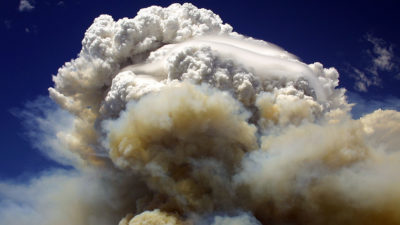Another Wrinkle In Climate Threat - Fire Storms, AKA Pyrocumulonimbus
 A pyrocumulonimbus cloud forms over the Willow Fire near Payson, Arizona in July 2004. Eric Neitzel / Wikimedia Commons
A pyrocumulonimbus cloud forms over the Willow Fire near Payson, Arizona in July 2004. Eric Neitzel / Wikimedia Commons
EDIT
As fires that would eventually consume 4,700 square miles in British Columbia burned out of control, five fire-driven thunderstorms rose over the conflagration, shooting black smoke and carbon high into the lower stratosphere,
spewing noxious gases that were eventually detected almost as far north as the North Pole, and touching off more fires. At the same time, fires in neighboring Washington State spawned yet another pyroCb. “By later that night we were agape about the cluster of pyroCbs and the extremely impressive smoky anvil-shaped clouds,” recalled Mike Fromm, a meteorologist at the U.S. Naval Research Laboratory.
Ed. - Emphasis added.
Later, Fromm and David Peterson, a colleague at the Naval Research Laboratory, labeled that day’s cluster of pyrocumulonimbus clouds “the mother of all pyroCbs,” surpassing even the events of Black Saturday in Australia in 2009 when monstrous bushfires killed 173 people, injured 414 others, and burned 1,700 square miles. On that night in February, three clearly distinct pyrocumulonimbus storms erupted across the state of Victoria in southeastern Australia.
Yet another major pyroCb event occurred in May 2016 during a massive wildfire in Alberta that forced the evacuation of 88,000 people in the tar sands community of Fort McMurray. A pyroCb formed over the fire that day, and lightning from the firestorm ignited several new fires in the forest 22 miles northeast of the fire’s front, astonishing wildfire experts. “I have never heard of lightning causing new fires so far in advance of the main fire,” said Cordy Tymstra, the wildfire science coordinator for the Alberta government.
 A pyrocumulus cloud developing above a major wildfire in southern Oregon in July 2014. James Haseltine / Oregon Air National Guard
A pyrocumulus cloud developing above a major wildfire in southern Oregon in July 2014. James Haseltine / Oregon Air National Guard
As a warming world causes larger, more frequent, and more intense wildfires, fire-driven thunderstorm events are on the rise in places — including Texas, Portugal, South Africa, and Argentina — where they have never occurred before. Mike Flannigan, director of the Canadian Partnership for Wildland Fire Science at the University of Alberta, says that pyroCbs seem to be on the rise because warmer temperatures are likely producing more intense fires with more vigorous plumes of smoke, black carbon, and water vapor, all of which increase the likelihood of pyroCbs. Whatever the reason, these episodes can wreak havoc on fire-suppression strategies. Flannigan says that pyroCbs fires are extremely hot and chaotic, especially when the plume collapses. Winds can reach the speed of a tornado. Embers shoot in all directions — in some cases up to three miles. That means sending firefighters in to fight them on the ground is impossible, according to Flannigan.
EDIT
https://e360.yale.edu/features/fire-induced-storms-a-new-danger-from-the-rise-in-wildfires

